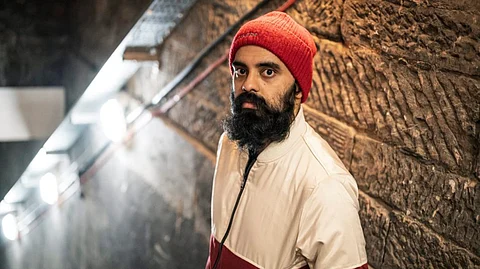
- HOMEGROWN WORLD
- #HGCREATORS
- #HGEXPLORE
- #HGVOICES
- #HGSHOP
- CAREERS
- ABOUT US
- CONTACT US

Glasgow-based artist Kapil Seshasayee can often be seen putting a Carnatic twist to tracks by artists like Khruangbin, Herbie Hancock, Manchester, Vulfpeck and even Mac Miller. But, being the true instrumentalist that he is, the artist does so by replicating the sounds of a veena and sitar with his guitar. In his career that spans over 20 years, Kapil has created music across genres like indie rock, avant-pop, art-rock, R&B and collaborated with artists across the globe. He’s a homegrown soundsmith who considers music to be his sonic and thematic playground.
Born in Tamil Nadu, Seshasayee was immersed in South Indian music from an early age. However, his upbringing in the UK, where discrimination often marked his experience as a person of colour, initially distanced him from his heritage. “Growing up, the discrimination was at times overwhelming, and I often resented being brown,” he reflects. But over time, this resentment transformed into a deep appreciation for his roots, which now informs his practice. His recent endeavours to integrate Carnatic music into his guitar playing also speak to this shift. “It’s been really fun teaching myself by ear,” he shares, emphasizing how natural it feels now to filter his heritage through his Western music background.
Seshasayee’s work is not only a personal exploration of identity but also a powerful commentary on socio-political issues such as caste, nationalism, and censorship. He refers to his songs as ‘sonic essays’, meticulously crafted to report on real events while engaging listeners with broader societal themes. The artist’s 2019 album, Laal, for instance, was a conceptual body of work exploring South Asian culture and identity through a unique Afrofuturistic lens. It addressed pressing issues like extreme nationalism, suppression of marginalized voices, caste discrimination, and the impact of Bollywood. His song Rupture of the Wheel, centered on the intersection of ableism and hyper-nationalism, inspired by the true story of a man in India, who was assaulted for not standing during the national anthem. “This narrative needs to change,” he asserts, underscoring his commitment to using music as a tool for activism.
As a Desi Futurist artist, Seshasayee challenges cultural stereotypes by merging Indian classical music with Western genres. His approach to hybridity is not just about musical experimentation but also about fostering inclusivity. “I try my best to be the change I want to see,” he explains, noting his collaboration with disabled rights campaigner and hip-hop producer Supermann On Da Beat. By choosing accessible venues for his performances and leveraging social media, Seshasayee ensures that his work reaches diverse audiences, particularly those often excluded from the live music experience.
Collaboration plays a crucial role in Seshasayee’s creative process, allowing him to maintain his artistic identity while expanding his musical horizons. He embraces ‘creative limitation’, often restricting himself to a few specific musical elements to forge a distinct voice. This disciplined approach does not stifle his creativity; rather, it enhances it, especially when working with artists across different genres. “I love working with a range of artists as there’s something to learn from every new collaboration,” he shares. His music benefits from these experiences and is enriched by the insights and techniques shared by his collaborators, whether they are famous protest musicians or contemporary rappers.
Kapil’s work highlights the power of music in negotiating and expressing dual cultural identities. By integrating his South Asian heritage with his Western musical background, he not only redefines his own identity but also challenges listeners to be aware of and to engage with complex socio-political issues. In doing so, he creates a more inclusive and nuanced musical landscape, where the personal and the political converge to inspire change.
Follow Kapil here and listen to his latest track, One Myna, below:
